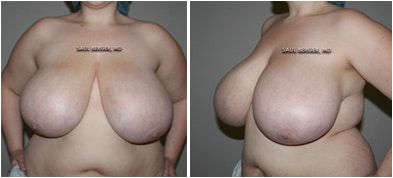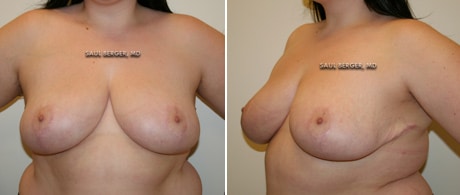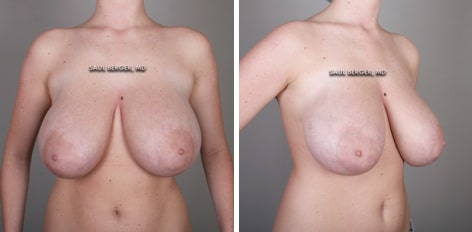The purpose of this section is to inform you about breast reduction surgery, and also to highlight some of the details that are important to your results. As you are guided through the "experience" of breast reduction, we hope you emerge with a better understanding of what is involved and how Dr. Berger and his team approach the procedure. Call 818.245.6101 today if you are interested in learning more, or if you wish to determine whether you are a candidate for breast reduction!
What Is Breast Reduction Surgery?
Breast reduction, or "reduction mammaplasty," is designed for women with heavy and large breasts and associated symptoms and possible medical issues. Some of the common complaints related to increased breast weight are pain in the back, neck or shoulders, formation of shoulder grooves from the bra straps, skeletal problems, restricted activities and skin irritation. Because of these health issues, breast reduction is sometimes, but not always, covered under health insurance. The operation involves removal of breast glandular tissue, fat, and skin, making the breasts smaller, lighter and firmer. It is also possible to reduce enlarged or wide areolas and to reduce highly projecting nipples. Along with the reduction in breast weight, the breasts are re-shaped and the nipples positioned higher as integral aspects of the procedure. The overall goal is creation of smaller, better-shaped breasts in proportion to the rest of one's body.
Who Is An Ideal Candidate For Breast Reduction?
In most cases, breast reduction isn't performed until a woman's breasts are fully developed; however, it can be done earlier if large breasts are causing serious physical problems. The best candidates are those who are mature enough to fully understand the procedure and have realistic expectations about the results. This is particularly important in view of the fact that permanent scars are a natural result of this operation. Breast reduction is not recommended for women who intend to breast-feed.
How Is The Breast Reduction Procedure Performed?
Nowadays, the operation is performed on an outpatient or "ambulatory" basis, unless there are associated medical problems or risk factors requiring hospitalization. Dr. Berger can offer breast reduction at his own private Medicare-accredited surgery center where you will feel like a celebrity.
A variety of techniques have been described in the medical literature for breast reduction. Essentially, they vary in how the incisions are made and the manner in which the nipple is raised. Commonly, surgeons employ an anchor or so-called "inverted-T" incision that encircles the areola, extends downward vertically, and then follows the natural curve of the crease beneath the breast. This approach has had high popularity in the U.S. with a solid track record. A second approach involves incisions only around the areola and extending downward, thereby omitting the long scar in the crease under the breasts. Some surgeons refer to this approach as a "vertical" mammaplasty option. With this approach, the manner in which the nipple is lifted and the excess skin removed are different from the anchor option. Patients having the vertical approach appreciate the avoidance of the long scar across the bottom as well as the absence of a visible scar at the cleavage area or near the underarm side. A third approach can be used for individuals with severe enlargement or other circumstances, and involves reducing the size of the breast while transplanting the nipple as a skin graft. Although the third approach is used infrequently, it can be a useful option in the properly selected patient. Finally, even liposuction has been used as a reduction technique. Liposuction has definite limitations and is unable to reduce breasts that are very dense. The results are also affected by the response of the skin to the reduction in breast tissue; this may be unpredictable. When it is feasible, however, liposuction has the distinct advantage of minimal scars. Interestingly, other techniques of reduction have been described, and entire books have been written on the subject. When you have a consultation with Dr. Berger, he will review the approaches which apply to you and how the operation would be planned in your particular case.
Is The Breast Reduction Procedure Safe?
Breast reduction is a very common operation that is normally safe when performed by a qualified plastic surgeon. As with any surgery, there are always risks, such as bleeding, infection, healing problems or reaction to the anesthesia. You can reduce your risks by closely following your physician's advice both before and after surgery. The procedure does leave permanent scars, although they will generally be covered by a bra or bathing suit. Poor healing and wider scars are more common in smokers. Future breast-feeding may not be possible, since the surgery affects the milk ducts leading to the nipple. Dr. Berger will review risks with you prior to surgery so that you are well informed.

Heavy breasts can lead to physical discomfort, a variety of medical problems, shoulder indentations due to tight bra straps, and extreme self-consciousness.
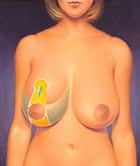
Incisions outline the area of skin, breast tissue, and fat to be removed and the new position for the nipple.

Skin formerly located above the nipple is brought down and together to reshape the breast. Sutures close the incisions, giving the breast it’s new contour.
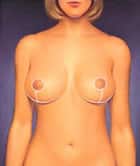
Scars around the areola, below it, and in the crease under the breast are permanent, but can be easily concealed by clothing.
If You Are Considering Breast Reduction, Here Are Some Of The Key Factors To Consider:
- What are your size and shape goals, and how do they compare to your current situation (skin type, shape, symmetry, nipple position, etc.) Are your expectations realistic to what the procedure can achieve? Do you already have differences between the two breasts prior to surgery (this is extremely common)?
- How is your health as a candidate for surgery? Do you have other significant medical conditions, allergies, or medications that needs to be considered? Are there factors, such as smoking, that can affect your results?
- Does your medical insurance cover reduction mammaplasty? While many policies cover breast reduction, your insurance company may not authorize the procedure for reasons such as obesity, insufficient weight of breast tissue for removal, or a specific exclusion from your medical benefits package. For patients who are not covered under insurance, they can make arrangements for the procedure at a reasonable out-of-pocket cost.
- Are there any aftercare procedures that would be able to enhance your overall results? Dr. Berger has specific recommendations that can reduce scar visibility.
Of course, the purpose of a thorough consultation is to obtain the necessary information from you while providing information about the procedure so that these choices are successfully made. One key to success for all patients is achieving "realistic expectations." The plastic surgeon can only work within the limitations of the individual's breast tissues and health status of each patient. Expecting to achieve results that your body cannot deliver or to be transformed into "a different person," such as your favorite celebrity, is not realistic to success!
By way of illustration, we would like to take you on a "journey" through some patients' experiences:
Case 1
A 28-year-old patient presented with heavy and debilitating breast enlargement. Although she was above ideal body weight at the time of surgery, her weight was stable and unlikely to change. Her health was otherwise good.
On the day of surgery, she was greeted by our surgical team at Boulevard Surgicenter in Los Angeles county and prepared for the operating room. After the start of anesthesia, the procedure was performed in 3 1/2 hours.
Our patient and her family received the aftercare instructions, which had already been reviewed at a previous pre-op visit. She was sore for several days, but achieved good relief with the pain medication. All of her sutures were dissolving type, and did not require removal.
At the time of her reduction, a total weight of 6 lbs. of breast tissue was removed! Her nipple position was raised, and overall shape improved:
Removing weight of this magnitude in any woman with significant breast enlargement is a life-changing operation; she was very pleased.
As you examine her pre-op images, you can appreciate the size and heaviness of her breasts. Both of the nipples are in a low position, and the skin has been stretched significantly:
Case 2
This case demonstrates an alternative reduction technique, which can offer tremendous advantages in terms of the incisions and scars. Whereas it is very common for patients to sustain an incision in the fold underneath the breasts where the bra underwire rests, this 22-year-old patient underwent a vertical reduction; that is, there is absolutely no scar in the fold underneath the breasts. Before surgery, you can appreciate the discrepancy between the patient's narrow body and her heavy breasts:
After the start of anesthesia, the procedure was performed in 2 3/4 hours. She was sore for two days, but was able to get around without much trouble. All of her sutures were dissolving type.
After surgery, one can see the dramatic improvement in size and shape and the limited scars compared with the "anchor" or "inverted-T" scar technique:
In this case, the patient was delighted that she had opted for the vertical reduction approach with Dr. Berger.
The choices of these patient and their results are not intended to imply that every patient will achieve comparable results or that any assumptions can be made about your particular case. The practice of medicine and surgery is not an exact science; although good results are expected, there are no guarantees. All surgery carries risks, and reviewing those risks is part of the process of preparing for surgery so that you are well informed. Hence, there is no substitute for scheduling a thorough consultation with plastic surgeon Dr. Berger to evaluate your situation and create your own specific plan. He consults with patients at his center in Burbank, California (in the Los Angeles area).
